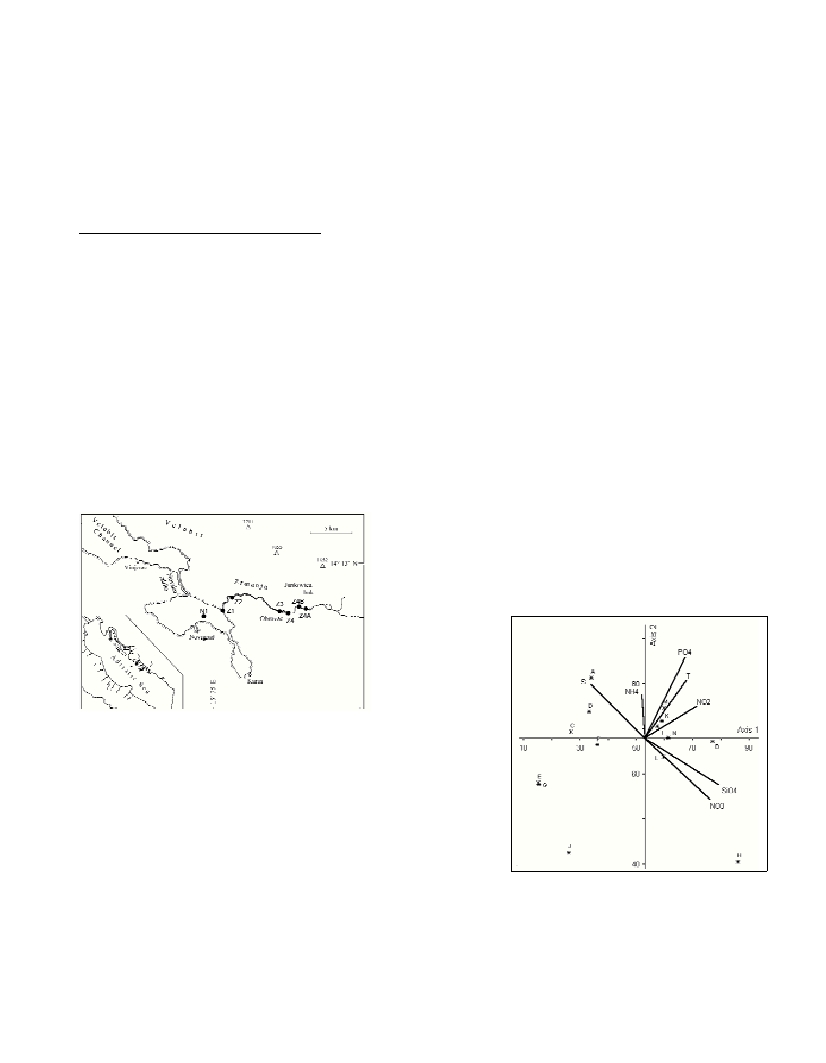DISTRIBUTION AND TAXONOMIC COMPOSITION OF PHYTOPLANKTON
IN A SHALLOW, ADRIATIC ESTUARY (ZRMANJA, JULY 2000)
Buric Z.
1*
, Cetinic I.
1
, Caput K.
1
, Vilicic D.
1
1
University of Zagreb, Faculty of Science, Division of Biology, Zagreb, Croatia - * zburic@zg.biol.pmf.hr
Abstract
The abundance and taxonomic composition of phytoplankton was determined in the highly stratified Zrmanja Estuary, eastern Adriatic
Sea, Croatia, during the low river in?ow (July 2000). Microphytoplankton accumulated in the middle reach of the estuary, were the living
conditions were most stabile. Accumulation of nanoplankton, at the head of the estuary, indicated higher microbiological recycling of
organic mater. CCA biplot indicated the diatom Chaetoceros socialis, as well as cryptophytes and nanoplanktonic dino?agellates,
developing exclusively in the estuary, while the rest of phytoplankton community had freshwater or seawater origin.
Key words: phytoplankton, estuary, Adriatic Sea
Rapp. Comm. int. Mer Médit., 37,2004
498
Introduction
The karstic Zrmanja River discharges into the Adriatic Sea forming
a small, highly stratified estuary. Stratified water column is
characterized by the sharp and shallow halocline (1). The concen-
tration of orthophosphates is low and increased downstream in the
estuary. Higher concentrations of total inorganic nitrogen (TIN) and
silicates (SiO
4
) is usually detected in the upper estuary. Concentration
and distribution of nutrients indicates oligotrophic conditions in the
estuary.
Material and Methods
The research was carried out in upper (StationsZ1, Z2, Z3, Z4,
Z4a, Z4b) and middle (Station N1) reach of Zrmanja Estuary (Fig.1)
in July 2000. Phytoplankton samples were taken using 5l Niskin
bottles at one meter intervals along the water column. Phytoplankton
was preserved in a 2% neutralized formaldehid solution and counted
by inverted microscope method (2). Canonical Correspondence
Analysis (CCA; 3) was used to display influences of environmental
conditions on distribution and taxonomic composition of dominant
phytoplankton taxa.
Results and Discussion
In July 2000, marine microphytoplankton dominated in the
community, below the halocline, in middle reach of the estuary
(5 x 10
5
cellsL
-1
). It was composed of diatoms (51%), dinoflagellates
(37%), coccolithophorides (8%), euglenophytes (2%) and
chrysophyceae (2 %). The abundance decreased in the upstream
direction. At the head of the estuary,at station Z4a, the abundance of
freshwater species (Dinobryonspp. and pennate diatoms) increased.
Freshwater phytoplankton sank to the halocline and died gradually in
the seaward direction.
Nanoplankton accumulated at the head of the estuary (6.4 x 10
5
cells L
-1
). It was composed of dinoflagellates, coccolithophorides,
cryptophytes and green flagellates.
Microphytoplankton reached maximum abundance in the middle
reach of the estuary due to most stabileliving conditions. On the other
hand, in the upper estuary, living conditions are stressful providing
adequate growth conditions only for nanoplankton. In the upper
estuary, nanoplankton was probably composed of mixotrophic species
that participate in the microbiological recycling of organic matter.
The frequent diatom in the estuary was Chaetoceros socialis,that
usually forms large chains and is thus considered as microphyto-
plankton. In the Zrmanja estuary it was present as single-cell species,
and followed the distribution of other nanoplankton.
Orthophosphates and nitritesare products of microbiological
regeneration in the estuary. Nanoplanktonic dinoflagellates (I),
cryptophytes (K) and Chaetoceros socialis(M) showed high
correlation (Fig. 2) with orthophosphates (PO4) and nitrites (NO2),
indicating their development exclusively in the estuary.
Green flagellates(L), freshwater pennate diatoms (N) and brackish
diatom Cocconeis scutellum (B) show high correlation with nitrates
(NO3) and silicates (SiO4) indicating their freshwater origin and
ability to maintain in the estuary.
The coccolithophoridSyracosphaera pulchra(A), as well as the
diatoms Proboscia alata(D) and Leptocylindrus danicus(C) showed
high correlation with salinity (S) and ammonium (NH4), indicating
their seawater origin.
Nanoplanktonic coccolithophorides (J), the diatoms Cyclotella
striata(F), Pseudo-nitzschiasp. (E) and the dinoflagellate Mesoporos
perforatus(G) showed negative correlation with the rest of the estuary
community, preferring lower temperatures (T) and higher salinity.
Conclusion
According to CCAbiplot, nanoplankton was the most characteristic
phytoplankton in the upper Zrmanja estuary, while micro-
phytoplankton came either from the sea or from the freshwater
accumulations above the estuary. Freshwater species mostly die in the
estuary, due to stressful environmental conditions along the salinity
gradient. Phytoplankton community in the Zrmanja estuary is
composed mostly of species that can tolerate stressful environmental
conditions.
References
1-Buric Z., Caput K., Olujic G., Vilicic D, 2003. Distribution of
phytoplankton and nutrients in the river Zrmanja estuary (July 2000).
Proceedings, 3
rd
Croatian conference on waters, Osijek, 28-31May 2003,
pp. 197-204.
2-Utermöhl, H., 1958. Zur Vervollkommnung der quantitativen
Phytoplankton Methodik. Mitt. Int. Ver. Theor. Angew. Limnol.9, 1-38.
3-Ter Braak, C. J. F., 1995. Ordination. In: Jongman, R. H. G., ter Braak,
C. J. F., van Tongeren, O. F. R., Data analysis in community and landscape
ecology. University Press, Cambridge.
Fig.1. Investigated area.
Fig. 2.
CCA ordination
biplot.
Species and
enviromental
labes are
listed in
the text.
Environmental
variables
are displayed
as lines.

